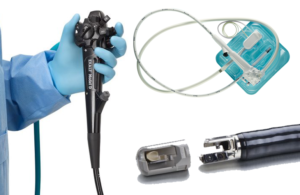
Luckily, several medical device companies have stepped in to solve the problems. (Here are five of the innovations.)
Duodenoscopes are flexible, lighted tubes threaded through the mouth, throat and stomach into the top of the small intestine. They’re an important tool for spotting problems such as lesions and tumors in the pancreatic duct and bile duct, but the devices are also complex, with many small working parts.
“Duodenoscopes – regardless of whether they are reusable or single-use – are one of the most technically complex flexible endoscopes to design and manufacture, as they travel deep into the body with a camera mounted on the side instead of the front,” David Pierce, EVP and president of MedSurg and president of endoscopy at Boston Sci, told Medical Tubing + Extrusion. “The device must be flexible enough to safely navigate tortuous anatomy, yet stiff enough to effectively deliver therapy to a patient’s biliary anatomy.”
Reprocessing them is tough — a bad situation because reprocessing failure can result in one person’s tissue or fluid remaining on the scope and going into someone else. By 2015, there were numerous reports of deadly “superbug” infections associated with the devices. The FDA later reported in 2019 that the reprocessing problem was a lot worse than previously thought —with contamination rates around 5.4% for high-concern bugs such as E. coli and Pseudomonas aeruginosa.
The FDA recommended in July 2020 that hospitals and endoscopy facilities consider using duodenoscopes with disposable components to lower the risks of infection. The agency also said it believes that the best solution for reducing the risk of disease transmission from duodenoscopes was through innovative device designs that make reprocessing easier, more effective or unnecessary.
Since the FDA recommendation, the agency has cleared several duodenoscope innovations – ranging from disposable duodenoscopes to disposable components that make reprocessing easier. Creating single-use scopes or scope components is not without challenges.
“In any single-use scope, the main challenge is to design an endoscope which is on par with the quality of a reusable while keeping the production costs low enough to make sense in hospital economy. A single-use scope must cost a fraction of a reusable scope and this is an innovation and manufacturing challenge,” Rasmus Kümmel Holtze, Ambu’s director of global product management in gastroenterology, said.
Here are five single-use innovations to reduce “superbugs.”

